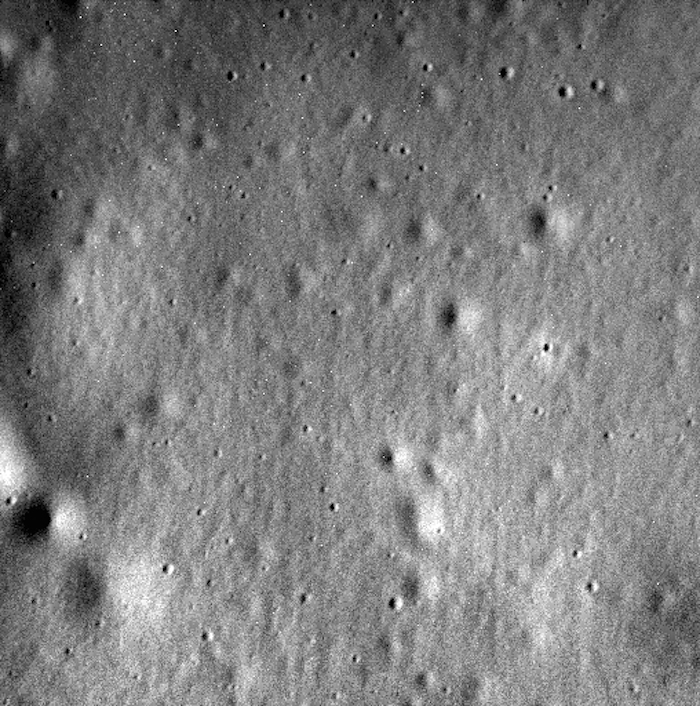.

Date acquired: April 30, 2015
Image Mission Elapsed Time (MET): 72716050
Image ID: 8422953
Instrument: Narrow Angle Camera (NAC) of the Mercury Dual Imaging System (MDIS)
Center Latitude: 72.0°
Center Longitude: 223.8° E
Resolution: 2.1 meters/pixel
Scale: This image is about 1 kilometers (0.6 miles) across
Of Interest: Today, the MESSENGER spacecraft sent its final image.
Originally planned to orbit Mercury for one year, the mission exceeded all expectations, lasting for over four years and acquiring extensive datasets with its seven scientific instruments and radio science investigation. This afternoon, the spacecraft succumbed to the pull of solar gravity and impacted Mercury's surface. The image shown here is the last one acquired and transmitted back to Earth by the mission. The image is located within the floor of the 93-kilometer-diameter crater Jokai. The spacecraft struck the planet just north of Shakespeare basin.
As the first spacecraft ever to orbit Mercury, MESSENGER revolutionized our understanding of the Solar System's innermost planet, as well as accomplished technological firsts that made the mission possible. Check out these movies of the Top 10 Science Results and the Top 10 Technology Innovations from the mission.
Planetary Data System Releases 14th Delivery of MESSENGER Data
Data collected during MESSENGER's 43rd through 49th months in orbit around Mercury were released to the public today by NASA's Planetary Data System (PDS), the network of nodes that archives and distributes data from NASA's planetary missions. With this release, all data acquired by the MESSENGER mission are now available online - data collected through eight full Mercury solar days of orbit about the innermost planet in our solar system.
NASA requires that all of its planetary missions archive their data in the PDS to provide documented, peer-reviewed datasets to the research community. This 14th delivery of MESSENGER data extends the formatted raw and calibrated data available at the PDS for the spacecraft's science instruments and the radio science investigation to the period from September 18, 2014, to April 30, 2015, when the MESSENGER mission ended with the spacecraft's anticipated impact onto Mercury's surface.
Ancillary spacecraft, planet, instrument, camera-matrix, and events (SPICE) data from launch through the end of spacecraft operations are included in this release.
The ACT-REACT QuickMap interactive Web interface to MESSENGER data has been updated to incorporate the full coverage of the Mercury Dual Imaging System (MDIS) orbital data and the Mercury Atmospheric and Surface Composition Spectrometer (MASCS) Visible and Infrared Spectrograph (VIRS) measurements included in this delivery. QuickMap can be accessed via links on the MESSENGER websites at http://messenger.jhuapl.edu/ and http://www.nasa.gov/messenger. MDIS mosaics can be downloaded from http://messenger.jhuapl.edu/the_mission/mosaics.html.
The data for this release are available online at https://pds.nasa.gov/tools/subscription_service/SS-20151009.shtml, and all of the MESSENGER data archived at the PDS are available at http://pds.nasa.gov.
This is the final scheduled release of MESSENGER raw data products. The final release of MESSENGER calibrated and advanced products is scheduled for May 6, 2016.
.

Bottom Image Scale: This image is roughly 130 km (81 miles) across.
Of Interest: The day before the MESSENGER spacecraft impacted the surface of Mercury, the best prediction for the location and time of the impact was 54.4° N, 210.1° E, on 30 April 2015 at 19.26:02 UTC, as shown in the featured image of that day.
In the last month since impact, MESSENGER engineers have completed the final and most accurate determination of where the MESSENGER spacecraft impacted Mercury’s surface. The determination indicates that the spacecraft impacted into a part of Mercury's surface that has a gradual incline with an approximate slope of 8.5°. The final estimate of the impact location is at 54.4398° N, 210.1205° E, and 2438.790 km from the center of Mercury. The final determination of the impact time is 19:26:01.166 UTC on 30 April 2015.
Traveling at 3.912 kilometers per second (8,750 miles per hour), the MESSENGER spacecraft is estimated to have created a crater 16 meters (52 feet) in diameter at this location. This new best determination of the impact location will help the next Mercury spacecraft to identify MESSENGER's crater, such as the joint ESA-JAXA BepiColombo mission, scheduled for lauch in 2017 and arrival in Mercury orbit in 2024.
The MESSENGER spacecraft was the first ever to orbit the planet Mercury. In the mission's more than four years of orbital operations, MESSENGER acquired over 270,000 images and extensive other data sets. View highlights of the mission in this image highlights collection and details about its final month of orbital operations at this page. MESSENGER's highly successful orbital mission came to an end, as the spacecraft ran out of propellant and the force of solar gravity caused it to impact the surface of Mercury on April 30, 2015.
Quelle: NASA
4319 Views
